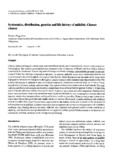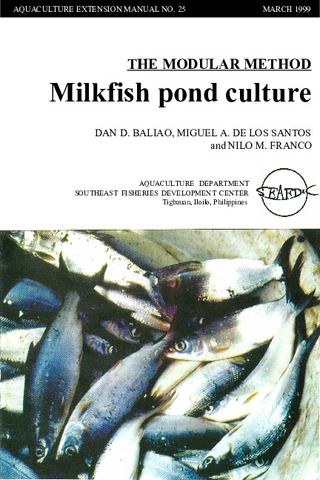Systematics, distribution, genetics and life history of milkfish, Chanos chanos
- Global styles
- MLA
- Vancouver
- Elsevier - Harvard
- APA
- Help

View/
Date
1994Author
Page views
6,242ASFA keyword
AGROVOC keyword
Taxonomic term
Metadata
Show full item record
Share
Abstract
Chanos chanos belongs to a monotypic gonorynchiform family and is most closely related to the freshwater Ostariophysi. The earliest gonorynchiforms occurred in the Cretaceous of Brazil and west Africa. Chanos occurred in the freshwater Eocene deposits of Europe and North America, and probably invaded the circumtropical Tethys Sea during transgression episodes. At present, milkfish occurs near continental shelves and around oceanic islands throughout the tropical Indo-Pacific. Milkfish populations throughout the range show high genetic variation but low genetic divergence, similar to many other commercially important teleosts. The natural life history of milkfish is one of continual migration. Adults are relatively large (to 1.5 m or 15 kg), long-lived (to 15 years), pelagic and schooling. They spawn offshore near coral reefs or small islands. The eggs, embryos and larvae are pelagic and relatively larger than those of most marine species. Larvae ≥ 10 mm long and 2–3 weeks old move inshore via a combination of passive advection and active migration. Passing shore waters and surf zones, they settle in shallow-water depositional habitats such as mangrove swamps and coral lagoons, where they metamorphose and spend a few months as juveniles. Some juveniles may enter freshwater lakes where they grow into sub-adults but do not mature. Both small juveniles and large sub-adults go back to sea when they reach the size limit supportable by the habitat. Little else is known of the dynamics of wild populations of milkfish. A fishery on inshore larvae supports the centuries-old aquaculture of milkfish in southeast Asia. During the past ten years, milkfish have matured and spawned under various conditions of captivity, and hatcheries have produced larvae to supply the culture ponds. Much remains to be learned concerning the milkfish, particularly its ecology and physiology.
Suggested Citation
Bagarinao, T. (1994). Systematics, distribution, genetics and life history of milkfish, Chanos chanos. Environmental Biology of Fishes , 39(1), 23-41. https://doi.org/10.1007/BF00004752
Type
ArticleISSN
0378-1909Collections
- Journal Articles [1258]
Related items
Showing items related by title, author, creator and subject.
-
Series: Aquaculture extension manual; No. 25
The modular method: Milkfish pond culture
Baliao, Dan D.; de los Santos, Miguel A.; Franco, Nilo M. (Aquaculture Department, Southeast Asian Fisheries Development Center, 1999)The modular method of milkfish culture (Chanos chanos) described in the manual is an improvement over the traditional extensive method. The manual is intended for the use of fish farmers and aquaculturists, extensionists, ... -
Evaluation of organic and inorganic fertilizers in brackishwater milkfish ponds
Bombeo-Tuburan, Isidra; Agbayani, Renato F.; Subosa, Precilla F. (Elsevier, 1989)The study was conducted in twelve 144-m2 ponds to evaluate the effect of different organic and inorganic fertilizers on the growth, survival, gross production, and profitability of marketable milkfish. The ... -
Milkfish breeding and hatchery technology at SEAFDEC/AQD
Unknown author (Aquaculture Department, Southeast Asian Fisheries Development Center, 1999)Describes the techniques already adopted by the private sector: broodstock management, broodstock diet, commercial fry production, live transport, and larval diet. A list of AQD research publications on milkfish is included.






